Imo
-
- Challenges facing IMO Maritime Reporter, Jun 2004 #26
The first months of my tenure as Secretary- General of the international Maritime Organization have seen an extremely busy and productive period at the International Maritime Organization (IMO). and in this yearbook I am grateful for the opportunity to reflect on the past six months in general and also to look forward to some of the challenges that lie ahead.
During the first half of 2004. three senior technical bodies have held meetings: the Maritime Safety Committee (MSC). the Marine Environment Protection Committee (MEPC) and the Legal Committee. IMO has also hosted five sub-committee meetings, a meeting of the Working Group on the Voluntary IMO Member State Audit Scheme and a diplomatic conference which succeeded in adopting a major new piece of international legislation, the International Convention for the Control and Management of Ships' Ballast Water and Sediments.
Much of the work that goes on at IMO is highly technical.
thorough, inevitably time-consuming and. by its very solid character, unlikely to capture the attention of the headline writers. Since the beginning of the year, for example, definitions and functional requirements have been agreed for "safe havens" with respect to fire aboard large passenger vessels; competency, training and certification requirements for ship security officers have been approved; guidance to Governments and to shipmasters relating to the treatment of persons rescued at sea has been developed and approved; and substantial revisions to the regulations on additional safe- ty measures for bulk carriers and tankers have been agreed. These and countless other significant and substantial items form a body of always important but frequently unsung work, of which all those connected with the Organization can feel justly proud.
One recent and innovative development is the concept that IMO should develop "goal-based" standards for ships' construction and equipment which was examined in detail by the MSC in May. There is, of course, no intention that IMO would take over the detailed work of the classification societies, but rather that IMO would state what has to be achieved, leaving classification societies, ship designers and naval architects, marine engineers and ship builders the freedom to decidc on how best to employ their professional skills to meet the required standards. At present there is no legislation lo control or guide these matters so the introduction of a mechanism to ensure harmonised, internationally agreed standards, under the umbrella of IMO. will be a positive step in the right direction.
At any given moment, the immediate and particular challenges facing IMO are subject to change. But the over-riding challenges always remain the same: • how do we improve global maritime safety still further?
• how do we continue to reduce any negative impact shipping has, or may have, on the environment?
And since September the I Ith: • how do we ensure that shipping is as secure from (he threat of terrorist intervention as il can possibly be.
without compromising, at the same time, the smooth flow of international maritime traffic?
Focusing first on the latter, interest and activity surrounding maritime security have naturally become particularly intense in the first half of 2004. leading up to the 1 July 2004 implementation deadline for the measures adopted by IMO at the end of 2002, including the new International Ship and Port Facility (ISPS) Code which is made mandatory under amendments to the International Convention for the Safety of Life at Sea (SOLAS). The terrorist atrocities on trains in Spain in March and the attacks on a port installation off Iraq in April served as a grim reminder of the vulnerability of all modes of transport to acts of terrorism.
But putting the regulatory framework in place is just part of the overall picture.
Governments and the industry were under no illusions from the outset that proper implementation of the new security measures was key. The Organization adopted a multi-faceted approach with a strong emphasis on practical work in the field, through regional and national seminars and workshops, which began in 2002, even before the security measures were formally adopted. Advisory and assessment missions have been organized, a Maritime Security Trust Fund established and model training courses developed for the Port Facility Security Officer, the Company Security Officer and the Ship Security Officer.
The implementation process was well under way during 2003 and into 2004.
In the IMO Secretariat, we have done all we can to urge and assist Members to move ahead and ensure compliance with the deadline set by the SOLAS Contracting Governments. The defences must be raised as high as possible and as early as possible. Terrorism is not a matter of concern to one country or a group of countries - it is a global issue and must be addressed as such. Prevention is so much better than cure, and the comforting yet complacent argument that some of us may hope never to become victims of a terrorist act is of no value here. With the interdependence of the world's economies today, the chain reaction that such an act may trigger will have a major negative impact on trade and the global economy — we will all be victims. In the marine environment field. February 2004 saw the adoption of an important new convention to address the issue of the management of ships' ballast water and sediments to combat the insidious problem of transporting marine micro-organisms across the world and depositing them in alien environments where they may upset the natural equilibrium and cause havoc with the local ecosystem. This is a major milestone in our quest to protect the maritime environment and we must now turn our attention to ensuring that the Ballast Water and Sediments Management Convention is both ratified and implemented. Only then can we be confident that the problem has been properly addressed.
We must also ensure that MARPOL* annex VI on Prevention of Air Pollution from Ships and the International Convention on the Control of Harmful Anti-fouling Systems on Ships come into force and are widely and effectively implemented.
When we consider our main goals of safety, security and pollution prevention, it is hugely important to ensure the preservation of the unity among the IMO membership which has served international shipping and the international community as a whole so well.
There is no doubt that an international industry like shipping, in which the prime physical assets - the ships themselves - actually move between countries and continents and therefore between different legal jurisdictions, simply has to be regulated internationaliy.
Conventions such as SOLAS and MARPOL derive much of their strength from the fact that they are applicable to nearly 100 per cent of the international fleet and are accepted universally. They give to each and every Party the confidence that the same, mutually acceptable standards are being applied on foreign vessels that visit their ports, and the right to take action whenever these agreed standards are not met. The alternative is impossible even to contemplate.
To expect ship operators to navigate through an archipelago of different standards and contrasting requirements would be completely impractical and the resulting confusion and misunderstanding would, I am sure, be detrimental to safety and environmental protection overall.
Given the universality of the IMO standards, another key challenge that the Organization is facing now and will continue to face in the future is to shift the focus of our Members and of the shipping community as a whole onto the implementation of existing regulations, rather than the formulation and adoption of ever more new standards.
Wherever changes in the existing regulatory regime are needed, they will, of course, be made and IMO, through its structure of sub-committees and working groups, is ideally placed to make sure that the framework we now have keeps pace with advancing technology and changing expectations. But, by and large, shipping accidents do not occur because of major gaps in the regulatory structure; in the main, they occur because what we already have has not been implemented effectively or because of human error.
Implementation of proper safety standards standards requires the development of a safety culture that embraces everyone involved in shipping, from the seafarers at the "sharp end" and those who work for shipping companies through to the officials and policy-makers in Governments and shipping administrations.
At IMO, we are doing all we can to develop and promote that safety culture, and we have quite consciously focussed our efforts on the human element.
The revised STCW* Convention, for example, lays down standards for training and certification, and is designed to ensure the industry's human resources can actually perform the tasks that their certificates suggest they can.
The International Safety Management (ISM) Code provides a blueprint for best practice at the managerial level within shipping companies. Our program of technical co-operation and assistance is designed to ensure that developing countries can get the help they need to develop their own maritime infrastructures and their own pool of able and qualified people.
The Organization is also currently responding to the increasingly vociferous calls to offer assistance to our Members in assessing to what extent they are implementing and enforcing applicable IMO instruments, with a view to enhancing their performance as flag, port and coastal States.
The development of the Voluntary IMO Member State Audit Scheme is progressing well towards the target of adoption of such a scheme by the IMO Assembly in 2005.
The scheme is envisaged to address such issues as conformance of the Member State in enacting legislation for the applicable IMO instruments to which it is a Party; the administration and enforcement of the applicable laws and regulations of the Member State; the delegation of authority by a Member State in terms of the implementation of convention requirements; and the control and monitoring mechanism of the Member State's survey and certification processes and of its recognized organizations.
Such a scheme would bring many benefits.
Identifying where capacity-building activities would have the greatest effect and targeting the appropriate • Bonds tenaciously to most surfaces including steel, plastic, fiberglass / composites, ceramic and wood I action would be greatly improved; the Member States themselves would receive valuable feedback, intended to assist them in improving their own capacity to put the applicable instruments into practice, and generic lessons learnt from audits could be provided to all Member States so that the benefits could be widely shared.
I see the audit scheme as a tool to enable us to make even further progress in eliminating sub-standard shipping.
It will satisfy our friends and silence those who label IMO as a "toothless tiger" with no real control over the implementation of the rules and regulations it develops. My vision is of a scheme which, rather than causing embarrassment to those to be audited by exposing their weaknesses, will instead bring us closer together - the one helping the other in pursuit of our common goals of enhanced safety and environmental protection.
For the future. I am also concerned by a number of other issues which we cannot afford to ignore.
It is essential that we find a way of addressing the question of safety standards aboard non-convention ships. The tragic ferry accidents in the Philippines and the Maldives this year have highlighted how devastating these incidents can be in terms of loss of life. IMO has already promoted the development, adoption and implementation of safety codes for non-convention vessels in Asia and the Pacific, Africa, the Caribbean and the Mediterranean, and will continue to explore initiatives to assist countries in avoiding these tragedies in the future.
Much has been written and spoken about introducing new legislation to criminalize those found responsible for causing pollution from ships through negligence.
Even though I fully understand the anger felt by victims and those whose coasts and livelihood are damaged by pollution, the concept of such legislation causes me serious concern.
Criminal prosecution for non-compliance was never envisaged when IMO Conventions were drafted and any moves in that direction should be weighed very seriously against the impact they will have on serving seafarers as well as on youngsters we try to attract to the maritime profession, particularly at a time when the statistics on the international maritime workforce paint a gloomy picture.
Moreover, the criminalization of individuals might also jeopardize effective response to a major incident, including by salvors, as it might lead to fear and indecision at crucial times.
Another serious concern is with regard to seafarers detained ashore following accidents involving ships on which they were serving. It is a complex issue and I understand and respect the independence of the judiciary in countries that have suffered in many ways as a result of accidents. However. I am very alarmed at the impact prolonged detention may have on the morale of the seafarers under detention and of the seafarers of the world as a whole who may justifiably fear for their future.
There is no doubt that an international industry like shipping, in which the prime physical assets - the ships themselves - actually move between countries and continents and therefore between different legal jurisdictions, simply has to be regulated internationally. IMO must add its weight to the global efforts of Governments and industry to prevent accidents happening in the first place and. consequently, remove any perceived incentive for unilateral or regional measures.
IMO has succeeded in improving standards in the past because it has never rested on its laurels and is always looking to move the agenda forward.
IMO today continues to provide a professionally sound and well considered regulatory mechanism which balances the demands of governments and civil society with the needs and capacity of industry.
Moreover, IMO has increasingly demonstrated its agility and its ability to fast-track consideration of issues that are considered urgent, but remain complicated.
It repeatedly shows itself to be capable both of reacting to events in an appropriate and timely manner and of anticipating and mitigating potential problems before they arise.
The goal for the standards that IMO adopts is that they be the highest practicable, which means that they should not only be of the highest level but capable of being implemented globally. The best possible witnesses to their success are the casualty and pollution statistics, which show continued improvement.
Overall, IMO is moving confidently towards further and greater achievements in the future, in order that we might move ever closer towards the goals encapsulated in our mission statement — safe, secure and efficient shipping on clean oceans.
-
- Interview: Kitack Lim, Secretary-General, IMO Maritime Reporter, May 2018 #34
As the International Maritime Organization (IMO) celebrates its 70th anniversary, Kitack Lim, Secretary-General, sits in his London office with a sense of satisfaction that in his two plus years at the helm of IMO tremendous strides have been made toward significant greenhouse gas emission reductions
-
- All Eyes on 2020 Maritime Reporter, Dec 2016 #24
IMO Low-Sulfur Fuel Mandate Triggers Mixed Reaction The International Maritime Organization’s proposals to reduce sulfur levels in marine fuels to a maximum of 0.5 percent m/m (mass/mass) by 2020 may prove to be controversial, having met with various responses from major shipping organisations and other
-
- Alphabet Soup Maritime Logistics Professional, Jul/Aug 2018 #56
Emissions monitoring and reporting means ECA’s, EPA VGP, EU MRV’s, IMO-DCS, RO’s, SEEMP – and you. Fear not: the daunting acronyms can all be managed by employing the right technology.In the past decade, shipowners have faced a raft of new regulations aimed at reducing the pollution from their ships,
-
- What’s All the Noise at IMO? Maritime Reporter, Nov 2014 #34
Shipping may think they hear the sound of new regulations as they are slammed onto their desks. What is all the noise concerning noise at IMO? This may very well be the question from ship owners, operators and builders closely following activities at the International Maritime Organization (IMO). In 2013
-
- What’s all the Noise at IMO? Marine Technology, Dec 2014 #20
Shipping may think they hear the sound of new regulations as they are slammed onto their desks. What is all the noise concerning noise at IMO? This may very well be the question from ship owners, operators and builders closely following activities at the International Maritime Organization (IMO). In 2013
-
- Insights: Johan Roos, Interferry's Executive Director of EU and IMO Affairs Marine News, Jan 2015 #12
Johan Roos is Interferry’s executive director of European Union and IMO affairs based in Brussels, Belgium. He took up the newly created regulatory affairs post in September 2011 after previously serving as director of sustainability with Sweden’s Stena Rederi AB. He holds a masters degree in environmental
-
- Trojan Marinex BWT System Earns IMO Type Approval Maritime Reporter, Apr 2014 #106
Trojan Technologies announced that the Trojan Marinex Ballast Water Treatment (BWT) product suite has obtained IMO Type Approval from DNV on behalf of the Norwegian Maritime Directorate. “We are the largest UV company in the world, and are committed to providing pioneering water treatment technologies that
-
- 71 Countries Make IMO's Initial STCW White List Maritime Reporter, Jan 2001 #53
a working group established to examine a report made by the secretary-general to the MSC, which revealed that 71 countries and one associate member of IMO has met the criteria for inclusion on the list. The 1995 amendments to STCW (The International Convention on Standards of Training, Certification and Watch
-
- USCG/IMO To Hold Oil Spill R&D Seminar In Washington, June 1 -4 Maritime Reporter, Apr 1992 #87
The U.S. Coast Guard and the International Maritime Organization (IMO) will co-sponsor a free seminar called, "International Oil Spill R&D Forum: Fostering International Cooperative Research," to be held in Washington, D.C., June 1-4. The workshop will focus on current and proposed R&D plans for
-
- IMO Pump Bulletin Describes Twin Screw Pumps Maritime Reporter, Nov 15, 1977 #44
, capable of moving large quantities of crude oil and almost any other liquid cargo or water ballast, are fully described in a bulletin published by the IMO Pump Division, DeLaval Turbine Inc. GTS pumps have particular application in the marine field, as they can handle liquids with an extremely wide
-
- DeLaval IMO Pump Division Publishes Illustrated Bulletin On Pumps For Gas Turbines Maritime Reporter, Apr 1976 #48
The IMO Pump Division of DeLaval Turbine Inc. has just published a six-page illustrated bulletin on IMO fuel and lube pumps for use with gas turbines. The bulletin gives specification and performance parameters for fuel injection, fuel transfer and lube applications. IMO pumps can operate on both petro
-
 )
April 2024 - Maritime Reporter and Engineering News page: 43
)
April 2024 - Maritime Reporter and Engineering News page: 43solution that meets ev- be in? uential if considered as part of the shipping, and to the vetting of the sys- ery objective, given the diversity of ship IMO’s review of its formulation of the tems in service.” types, ship ages, routes and services.” CII, or as EU standards evolve to sup- What is also already
-
 )
April 2024 - Maritime Reporter and Engineering News page: 42
)
April 2024 - Maritime Reporter and Engineering News page: 42for what's going on onboard ships at the impact of ship greenhouse gas emissions, includes owners, managers, mariners, moment,” says Lehtovaara. with IMO soon expected to follow. shipyards, equipment makers, designers, Today, ships are ? lled with standalone With all levels of society increas- research
-
 )
April 2024 - Maritime Reporter and Engineering News page: 41
)
April 2024 - Maritime Reporter and Engineering News page: 41crew welfare. enced of? cers and crew, we anticipate that integrated ship situational awareness technology will be a mandatory require- ment from the IMO by 2030. Before that will come class notations and voluntary IMO guidance, probably by 2026. Groke Pro has an extensive reference list from Japanese
-
 )
April 2024 - Maritime Reporter and Engineering News page: 14
)
April 2024 - Maritime Reporter and Engineering News page: 14Raymond Fischer uantitative underwater radiated noise limits will construction inspections, 5) possible training with respect to be developed shortly by IMO, and/or countries salient design/construction essentials, 6) compliance veri? ca- like Canada and the EU. In the past, only quieting tion methods
-
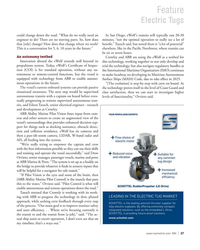 )
April 2024 - Marine News page: 37
)
April 2024 - Marine News page: 37the technology, but also navigate regulatory hurdles as tion (COI) is for standard operation, without any au- the International Maritime Organization (IMO) continues tonomous or remote-control functions, but the vessel is to make headway on developing its Maritime Autonomous equipped with technology
-
 )
February 2024 - Maritime Reporter and Engineering News page: 36
)
February 2024 - Maritime Reporter and Engineering News page: 36than 100 shaft generators in operation Additionally, shipowners can move further towards the and well over 100 in its production pipeline. Most commonly IMO’s 2050. They can test out energy storage and fuel cell to date, orders have been for 174,000cbm LNG carriers. These equipment, he says, and see what
-
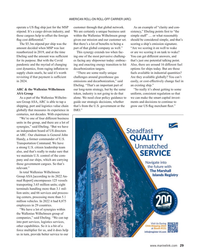 )
February 2024 - Maritime Reporter and Engineering News page: 29
)
February 2024 - Maritime Reporter and Engineering News page: 29, port and logistics value chain that’s from the U.S. government or the grow our US ? ag merchant ? eet.” globally that measures its experience in IMO.” centuries, not decades. With experience “We’re one of four different business units in the group, and there are a lot of synergies,” said Ebeling
-
 )
February 2024 - Maritime Reporter and Engineering News page: 24
)
February 2024 - Maritime Reporter and Engineering News page: 24V228 for the bore size in millimeters. to do concurrent design and reliability demonstrations. We’re With the advent of emissions regulations for EPA and IMO, able to learn across both applications to make them better Wabtec developed a marinized version of its Evolution-series where one application might
-
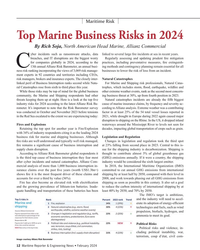 )
February 2024 - Maritime Reporter and Engineering News page: 12
)
February 2024 - Maritime Reporter and Engineering News page: 12be considered the sixth largest emitter. mercial analysis of more than 1,000 business interruption in- In 2018, the International Maritime Organization (IMO) surance claims over the past ? ve years (worth US$1.3bn+) committed to cut annual GHG emissions from international shows ? re it is the most frequent
-
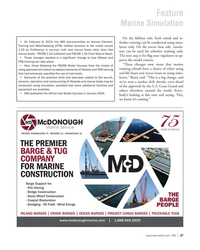 )
February 2024 - Marine News page: 37
)
February 2024 - Marine News page: 37Feature Marine Simulation On the lifeboat side, both initial and re- • On February 9, 2023, the IMO sub-committee on Human Element, fresher training can be conducted using simu- Training and Watchkeeping (HTW) rati? ed revisions to the model course lators only. On the rescue boat side, simula- 1.23 on
-
 )
February 2024 - Marine News page: 36
)
February 2024 - Marine News page: 36we were the ? rst ones there with a DNV been deploying to various sites where they can do mobile certi? cate at the International Maritime Organization (IMO).” training. “They’ll have a crew coming off a ferry at a cer- Burry emphasized the signi? cance of recent changes at tain terminal, for example, and
-
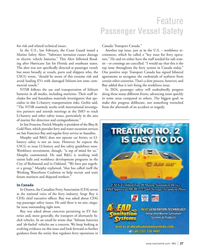 )
February 2024 - Marine News page: 27
)
February 2024 - Marine News page: 27wrenched “The NTSB routinely works with international investiga- from the aftermath of an accident or tragedy. tive partners and attends meetings at the IMO to track Li-battery and other safety issues, particularly in the area of marine ? re detection and extinguishment.” In San Franciso, Patrick Murphy
-
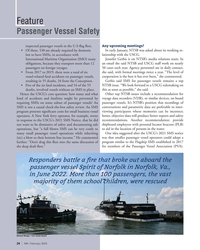 )
February 2024 - Marine News page: 24
)
February 2024 - Marine News page: 24early January, NTSB was asked about its working re- law to have SMSs, in accordance with lationship with the USCG. International Maritime Organization (IMO) treaty Jennifer Gerbis is on NTSB’s media relations team. In obligations, because they transport more than 12 an email she said NTSB and USCG
-
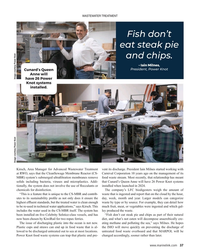 )
January 2024 - Maritime Reporter and Engineering News page: 37
)
January 2024 - Maritime Reporter and Engineering News page: 37into the ocean is not new. ating methane and polluting the sea,” says Milnes. He hopes Plastic cups and straws can end up in food waste that is al- the IMO will move quickly on preventing the discharge of lowed to be discharged untreated out to sea at most locations. untreated food waste overboard and
-
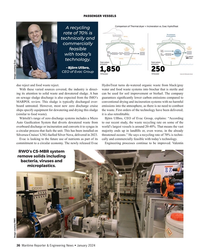 )
January 2024 - Maritime Reporter and Engineering News page: 36
)
January 2024 - Maritime Reporter and Engineering News page: 36to solid waste and dewatered sludge. A ban can be used for soil improvement or biofuel. The company on sewage sludge discharge is also expected from the IMO’s guarantees signi? cantly lower carbon emissions compared to MARPOL review. This sludge is typically discharged over- conventional drying and incineratio
-
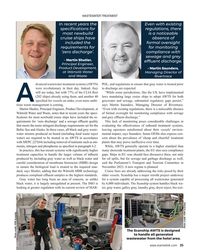 )
January 2024 - Maritime Reporter and Engineering News page: 35
)
January 2024 - Maritime Reporter and Engineering News page: 35long been an area of concern, as unlike for a system capable of processing all wastewater generated black water, it is largely unregulated at present. The IMO is by 6,000 individuals. The Scanship system handles black wa- looking at greater regulation with its current review of MAR- ter, gray water, galley
-
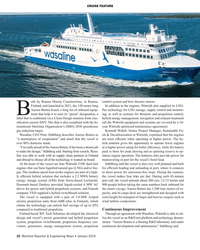 )
January 2024 - Maritime Reporter and Engineering News page: 32
)
January 2024 - Maritime Reporter and Engineering News page: 32society DNV. The ship is also compliant with the In- (all the Wärtsilä equipment and systems are covered by a 10- ternational Maritime Organization’s (IMO) 2030 greenhouse year Wärtsilä optimized maintenance agreement). gas reduction target. Kenneth Widell, Senior Project Manager, Sustainable Fu- Wasaline
-
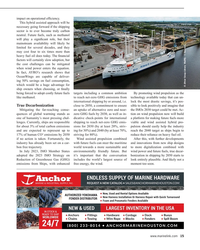 )
January 2024 - Maritime Reporter and Engineering News page: 15
)
January 2024 - Maritime Reporter and Engineering News page: 15to 2050, a commitment to ensure sible to look positively and imagine that Mitigating the far-reaching conse- an uptake of alternative zero and near- the IMOs 2030 target could be met. Ac- quences of global warming stands as zero GHG fuels by 2030, as well as in- tion on wind propulsion now will build one
-
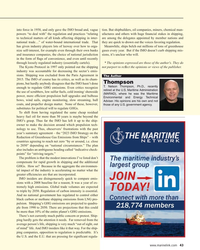 )
December 2023 - Maritime Reporter and Engineering News page: 43
)
December 2023 - Maritime Reporter and Engineering News page: 43into force in 1958, and only gave the IMO broad and, vague tion. But shipbuilders, oil companies, miners, chemical man- powers “to deal with” the regulation and practices “relating ufactures and others with huge ? nancial stakes in shipping, to technical matters of all kinds affecting shipping in inter-
-
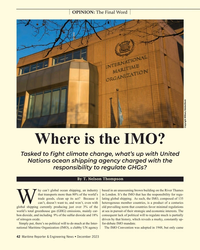 )
December 2023 - Maritime Reporter and Engineering News page: 42
)
December 2023 - Maritime Reporter and Engineering News page: 42OPINION: The Final Word Copyright William/AdobeStock Where is the IMO? Tasked to ? ght climate change, what’s up with United Nations ocean shipping agency charged with the responsibility to regulate GHGs? By T. Nelson Thompson hy can’t global ocean shipping, an industry based in an unassuming brown
-
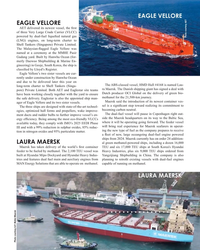 )
December 2023 - Maritime Reporter and Engineering News page: 39
)
December 2023 - Maritime Reporter and Engineering News page: 39en- ergy ef? ciency. Being among the most eco-friendly VLCCs side the Maersk headquarters on its way to the Baltic Sea, available today, they comply with IMO’s 2025 EEDI Phase where it will be operating going forward. The feeder vessel will bring real experience for Maersk seafarers in operat- III and with
-
 )
December 2023 - Maritime Reporter and Engineering News page: 38
)
December 2023 - Maritime Reporter and Engineering News page: 38of cargo volume per day for improved ef? ciency. Far East route between Asia and Europe. Powered by WinGD X-DF propulsion, the vessels ful? ll the IMO Tier-III emission requirements without any external exhaust gas after- SERI DAMAI treatment system. It also complies with the Energy Ef? ciency Existing
-
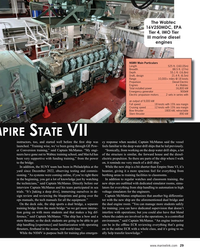 )
December 2023 - Maritime Reporter and Engineering News page: 29
)
December 2023 - Maritime Reporter and Engineering News page: 29The Wabtec 16V250MDC, EPA Tier 4, IMO Tier III marine diesel engines NSMV Main Particulars Length 525 ft. (160.05m) Breadth 88.5 ft. (27m) Depth 55.1 ft. (16.8m) Draft, design 21.4 ft. (6.5m) Range 10,000+ miles @ 18 knots Propulsion Diesel Electric Engines 4 x Wabtec Total installed power 16
-
 )
December 2023 - Maritime Reporter and Engineering News page: 28
)
December 2023 - Maritime Reporter and Engineering News page: 28engines. The project to design, build and Anchoring the platform are Wabtec’s 16V250MDC, EPA Edeliver the NSMV series is one of the most exciting Tier 4, IMO Tier III marine diesel engines, a total of 20 pow- shipbuilding programs in the U.S. – a government shipbuilding erplants – four per ship – designed
